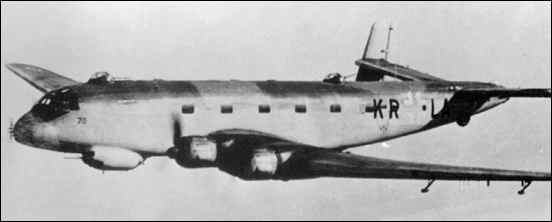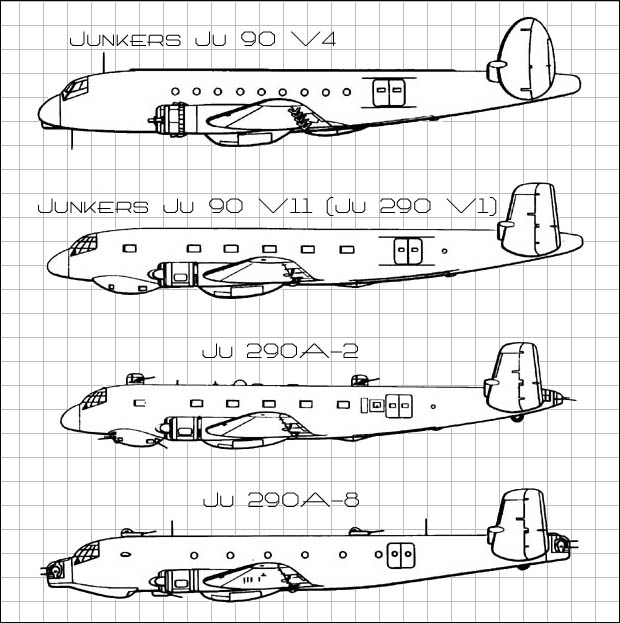Junkers Ju 290

How about this cool looking transport aircraft.
The Junkers Ju 290 was a long-range transport, maritime patrol aircraft and heavy bomber used by the Luftwaffe late in World War II.
The first combat model was the Ju 290A-2. This was basically a Ju 290A-1 with FuG 200 Hohentwiel search radar. The Hohentwiel radar could detect a convoy at a distance of about 100km. The Trapoklappe was retained. The Ju 290A-3 was almost identical, but had a Focke-Wulf gun turret with a lower profile. The A-4 model had an additional dorsal gun turret, further aft. On 15 October 1943 Fernaufklaringsgruppe 5 (FAGr.5) began operations from Mont-de-Marsan, in France. They replaced the Fw 200C in its role of gatherer of information for the U-boats. After two A-2s, three A-3s, and five A-4s, it received the first A-5.
The A-5 was a fully operational combat aircraft, and appeared in the spring of 1944. It had protected fuel tanks, armour plating for the crew positions, and redesigned beam gun positions. Also, all but one of the 13mm MG131 guns were replaced by 15mm MG151 cannon, with a difference in firepower much larger than the small increase in calibre suggests. The crew was increased for seven to nine. The Ju 290A-5 was well armed, could absorb damage and did not have the structural weaknesses of the Fw 200C. This was a good replacement for the Condor, but only 11 were completed.
And three Ju 290A-5s were retracted from FAGr.5 after delivery. All their armament was removed, and additional fuel tanks installed. They made a non-stop trip to Manchuria, and a similar flight back, to exchange documents and strategic materials with the Japanese. After the loss of the Atlantic coast, the Ju 290s were all used as transports. Some went to the famous KG200, that seems to have used the bombers to drop agents and supplies behind the Allied lines.
Despite an order for 25 of them, Junkers completed only a few A-7s, which had an additional MG151 in a bulbous, glazed nose and was equipped to carry guided weapons. The A-8 had again increased armament, but only three or four were completed. The final version, Ju 290A-9, had reduced armament but more fuel, so that range could be increased to 8300km. The production programme was hit when the Red Army occupied the factories near Prague, but in October 1944 the programme was completely terminated: Germany could no longer afford to build the Ju 290. It needed to concentrate all resources on just a few types. The Ju 290B, C, D and E models never left the drawing board.
Flights to Japan
Following the invasion of the Soviet Union in June 1941, plans were made to connect Germany and Japan by air using Luftwaffe aircraft modified for very long range flights. Commercial flights to the Far East by Luft Hansa were no longer possible, and it had become too dangerous for ships or U-boats to make the trip by sea. Field Marshal Erhard Milch authorized a study into the feasibility of such direct flights. Various routes were considered, including departing from German-occupied Russia and Bulgaria. Nautsi, near Lake Inari in the north of Finland, was finally selected as the optimum starting point for a great circle route along the Arctic Ocean then across eastern Siberia, to refuel in Manchuria before completing the flight to Japan.
In 1943, the Ju 290 was selected for the flights and tests began in February 1944 of a Ju 290 A-5 (works number 0170, KR+LA) loaded with 41 tonnes (45 tons) of fuel and cargo. Three Ju 290 A-9s (works numbers 0182, 0183 and 0185) were modified for long-range work at the Junkers factory in March 1943. The plan was eventually put on indefinite hold after the Japanese failed to agree on a course, as they did not want to provoke the Soviet Union by an overflight of any part of their Siberian territory, and the three aircraft were eventually transferred to KG 200. 0182 was lost in action in Russia, 0183 was wrecked at Travemünde, and 0185 was found to be unrepairable following a mission in Russia, all during 1944.
The Japan flights were revived again in December 1944, mainly to transport Luftwaffe General Ulrich Kessler to Japan as a replacement for the German air attaché in Tokyo. Ju 290 A-3, no. 0163, was flown to Travemünde for the necessary modifications, but the work was delayed and it was decided to send Kessler aboard the submarine U-234 instead. The aircraft was destroyed on 3 May 1945 as British troops arrived. Some sources claim that the trips to Japan actually took place, departing from Odessa and Mielec and landing in Manchuria.
KG 200
The Luftwaffe Special Operations squadron, KG 200 used the Ju 290 amongst its various aircraft types. The most historically known KG 200 Ju 290 mission was flown on the night of 27 November 1944. KG 200 pilots Braun and Pohl flew a Ju 290 from Vienna to a position just south of Mosul, Iraq, where they successfully air-dropped five Iraqi parachutists. Staging through the island of Rhodes, still under German occupation, they evacuated some 30 casualties from there back to Vienna.
Hitler's personal transport
On 26 November 1943, Ju 290 A-5, no. 0170, along with many other new aircraft and prototypes, was shown to Adolf Hitler at Insterburg, East Prussia. Hitler was impressed by its potential and told Goering that he wanted a Ju 290 for his personal use. A Ju 290 was not however assigned to theFliegerstaffel des Fuehrers (FdF) until late 1944, when an A-7, works number 0192, was supplied, which had formerly assigned to the maritime reconnaissance unit FAGr 5 (Fernaufklärungsgruppe 5). Modifications were completed by February 1945 at the FdF's base at Pocking, Bavaria, a Stammkennzeichen alphabetic designation code of KR+LW being applied. Hitler's pilot, Hans Baur, tested the aircraft, but Hitler never flew in it.
The aircraft was fitted with a special passenger compartment in the front of the aircraft for Hitler, which was protected by 12 mm (.5 in) armour plate and 50 mm (2 in) bulletproof glass. A special escape hatch was fitted in the floor and a parachute was built into Hitler's seat; in an emergency it was intended that he would put on the parachute, pull a lever to open the hatch, and roll out through the opening. This arrangement was tested using life-size mannequins.
Hans Baur flew the aircraft to Munich-Riem airport on 24 March 1945, landing just as an air-raid alert was sounded. Parking the plane in a hangar, he went to his home. Upon returning to the airport, he discovered that both the hangar and the aircraft had been destroyed by U.S. bombers.
Amerika Bomber
The long range of the Ju 290 made it a good candidate for further development concerning the Amerika Bomber project, competing with the three airworthy examples of the Messerschmitt Me 264, the never-built Heinkel He 277 and Focke-Wulf Ta 400 designs, and as a result, the six-engined Ju 390, based directly on the Ju 290 airframe with even longer range was built in prototype form, two airframes being completed and test-flown. As Germany lost access to the ocean, their role soon evaporated, and by October 1944, all production was stopped.
Type:
– Long Range Transport
– Reconnaissance Bomber
– Maritime Patrol
Origin: Junkers Flugzeug und Motorenwerke
Models:
Ju 290A-1 to A-8 and B-1, B-2 and C
General characteristics
Crew: 9
Length: 93 ft 11 in (28.64 m)
Wingspan: 137 ft 9 in (42.00 m)
Height: 22 ft 5 in (6.83 m)
Max takeoff weight: 99,141 lb (44,970 kg)
Powerplant: 4× BMW 801G/H 14-cylinder radial engines, 1,700 hp each
Performance
Maximum speed: 273 mph (440 km/h)
Range: 3,843 mi (6,150 km)
Service ceiling: 19,680 ft (6,000 m)
Armament
Guns:
2 × 20 mm MG 151/20 cannons in dorsal turrets
1 × 20 mm MG 151/20 in tail
2 × MG 151/20s at waist
1 × MG 151/20 in gondola
2 × 13 mm (.51 in) MG 131 machine guns in gondola
Bomber versions could carry up to 3,000 kg (6,600 lb) of disposable stores or up to three Fritz X or Henschel Hs 293 radio-guided munitions, though these were not widely used
Avionics
FuG 200 Hohentwiel radar




